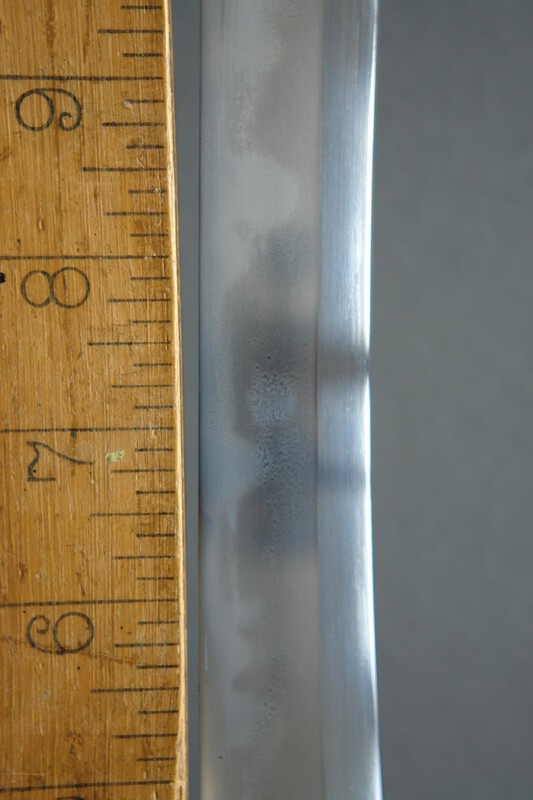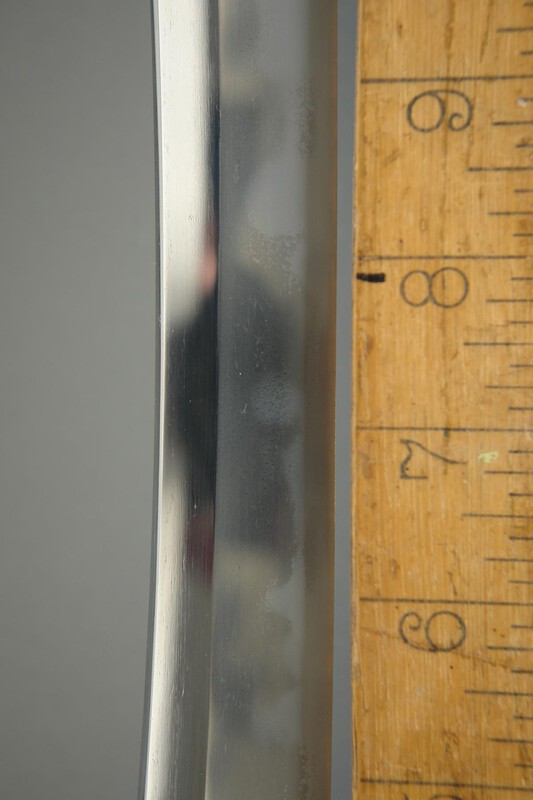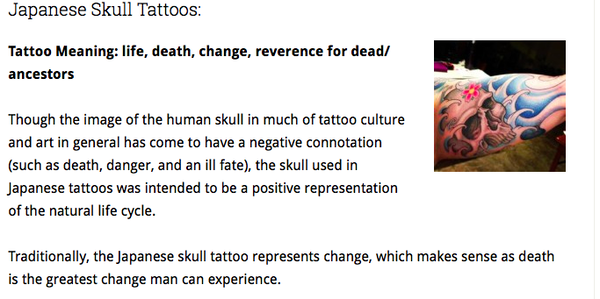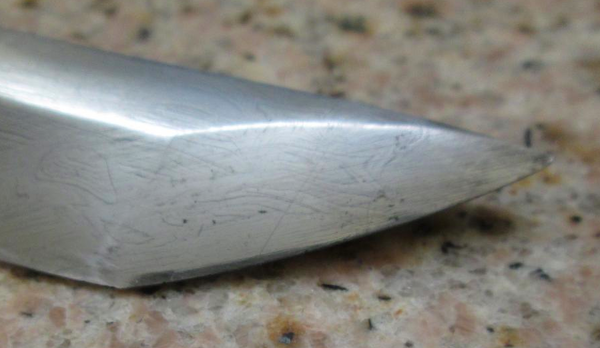-
Posts
1,066 -
Joined
-
Last visited
-
Days Won
6
Content Type
Profiles
Forums
Events
Store
Downloads
Gallery
Everything posted by Dr Fox
-
Follow up on George, photos show both menuki with the same orientation, i.e. both frames right over left, how does it look if you rotate one and have right over left. left over right. Does it scan?.
-

Soild Gold Menuki School Identification
Dr Fox replied to i h8 mud nz's topic in General Nihonto Related Discussion
Its very appealing, how the wrap is figured to show the menuki at their best. -
Josh With you on wanting to keep as is a piece of history. But as you point out it is rotting away, and will not get any better. Handling the item will of course accelerate, exactly what you are trying to avoid. But there are times when we have to bite the bullet, and accept an items life expired date. So where are you now!. 1. Strip and reuse core and fittings. (note Fords post!) 2. Have a new tsuka made in sympathy with the old, and keep a complete koshirae. Point: When organic items get to the point of disintegration, they do not reflect their former glory anyway, so little is gained.
-
Ben priceless. Consider digital copies to preserve these. The reproductions would be amazing.
-
Most of the visible yasurime slant downwards across the tang, but there are also horizontal and contrasting file marks, filling in the space below the machi down to the slanting file mark pattern that covers most of the tang. Its called Kesho yasuri. I would like to think this is what we have here. It is a change from the norms seen, and it was the feature which caught and held my attention to this blade. What a bonus, well done. Scanning back Jaques D, had this pinned down.
-
Grev Iwas lucky enough to do the same thing.
-
Hi Rich The word 'tasteful' has a key role here for me. Tasteful to who? Japanese and Western tastes don't always run together, some times never. So from which ever perspective you are viewing from, will perhaps answer.
-
Hi Kurt I am at this very time doing just what you are trying to achieve. One of the important aspects of the task, is to get it 'right'. My problem was to source the fittings, not only to theme, but also to fit. Tsuba's of age deserve respect, and file alterations are deffo a no.no. Plain guesswork, or taking a chance, will end up with you buying pieces that don't fit or just don't look right in hand. For me the task was greatly helped by having good friends, that I could talk to and visit, to chat out the various aspects of the task. With blade in hand and a selection of themed fittings available, i achieved the perfect outcome. A blade in shirasaya is a blank canvas. My initial task was an habaki, then seppas, now ready a tsuba that fits, one with a 'theme', from there you have your base. Take your time! I am into 30 months up to now, and still some way to go. Act in haste, repent at leisure. Edit: Should you find a tsuba that is fitted with sekigane (fitting inserts) and they are preventing the fit, it is acceptable to file the inserts to fit. But then check that the nagako ana, is a comfortable shape under the seppa.
-
Should I be a much younger man, and had a yearning to pursue this highly technical craft. I would have to seek out the best western polisher, wherever he resided. Why? Simply because of the language barrier, unless fluent in Japanese, and not just at a conversation level, but also able to understand all the nuances of the technical aspects of the craft. I would also need a great deal of sword knowledge, to appreciate what different profiles blades had, from different era's and smiths. So even starting to master, the two latter subjects at a young age, it would be as a much older man, that a polishing apprenticeship could be considered. Sword polishing is a Japanese craft, and as such presents barriers to non Japanese persons. This will go a long way to discourage entry to the craft.
-

First Japanese Blade And Restoration Proyect
Dr Fox replied to dominnimod's topic in General Nihonto Related Discussion
I see the word 'restore' being in frequent use in this posting. Restore to 'what'?. Flat abrasive, sandpaper, acid etch and home polishing? I have seen folks shot, for a lot less than this on here. -
Hmmmmm, is it just me, or is it getting warm in here?
-
Alex have you checked the size of the ana in the nakago, against the ana in the tsuka. Should the nakago ana, be larger than that in the tsuka, it will not snug up to tight, there will always be play. A thicker seppa will of course set back the mekugi against the nakago ana.
-
On the face of it, what is being sold here? These blades have an attractive look, and a price tag that most folks could afford! What I find a puzzle is, why go to the trouble of adding a spurious mei? If they are meant to fool those who don't know better, then a mei is not going to impress the don't knows. The mei is what gives the call ‘fake’. Without, is it a copy? Or a modern made katana, not pretending to be anything else. A Paul Chen is what it is, and presented so, so whats the deal here? Tamahagane? Not at this money!
-

Possible Showa/ww2 Blade, Translation Help Needed
Dr Fox replied to Pika007's topic in Translation Assistance
"seems like sandpaper" hits the spot. -
I have a good friend who presented himself here with a gunto wooden hilt (1945 NCO). But the blade didn't look a factory knockout. The blade was signed, I mentioned that I could ask here for translation. I expected a good wait for an answer. Lo and behold bingo, you had come up trumps. What an excellent opportunity you gave me to show off, lol. Thank you.
-
Stephen You were off the mark double quick, my good friend how? Yes its easy to see when one is pointed in the right direction. Many thanks.
-
-
I have been content in the knowledge, that no, this is not him! But pleased with this blade, it is a beefy and balanced piece. And with the oddities it has, gives it its own history. The links you provided I will use to see examples of their works. Thank you for the generosity of your time, much appreciated.
-
The point you made on the will of the sword, opposing the skill of the smith, is noted. Also the skill needed to accomplish a faultless result, would have to be of the highest standard. The other points you make give food for further thought. More on that in a minute. This blade has at least 6 areas where it can be supposed a mirror attempt has been made, The position of the measure indicates, this is not a random accident. Now the other point. The fashioning of the hamon is pre yaki-ire, so from there, the desired effect is now expected. So if a smith had the intention, of producing the characteristics of a known smith, then the attempt of mirroring, would be deliberate and not accidental. Where am I going with this? It leads from your comment that “it could be someone trying to copy ‘Sukehiro’ This blade is signed ‘Sukehiro’, gi-mei when compared to examples I have seen. One will never know! But was this made to deceive, or the mei added later because of the hamon? Either way your return post was most informative thanks.
-
Thanks Axel and Darcy. Axel, yes you got as far as I did! The two examples were just to show the standard of photo to be worked on. Darcy, the other examples (5) all have a similarity in hamon, using the yardstick the examples are surprisingly on 'measure'. "This is the earliest I've seen' Is that a reference to this blade?
-
Having read articles in the past on the subject, of hamon showing a mirror image both sides of the blade. My attention has been drawn to a wakizashi, which in hand looks as if an attempt has been made, to create such an effect. Now, just how accurate this effect has to be, to be considered a mirroring, I don't know. So as an exercise, I decided to photograph both sides of the blade at several points, using a rule at the hamachi for reference. I have the images, but here's where I ask for members assistance please. I do not have image enhancing software. What is now needed is tweaking to enhance the hamon, and placing two images ha to ha in one shot, for comparison. To the skilled amongst us I hope this is no big deal. I will add two images out of the six comparisons I have. Thanks in advance for any help. this will be for board appraisal when completed. Regards.
-
Pietro To follow up on the 'theme' of your nuki. Yes the fox has an important place in folklore, and so does the skull! And rather luckily in your case, there is a nice link for them together. A kitsune may take on human form, an ability learned when it reaches a certain age—usually 100 years, although some tales say 50. As a common prerequisite for the transformation, the fox must place reeds, a broad leaf, or a skull over its head. The skull also has an important place in Japanese tattoo's, going far back in time. Hope this brings a little more pleasure to your items!
-
As issued to alcoholic kamikaze? With ana for neck cord!.
-
Glad you decided to post. I think they are excellent little pieces. I will have to keep an eye out in future, I would buy such as these, and would delight in using same. Thank you for sharing.
-

Please Help With Signature,is This Real
Dr Fox replied to lumhechati's topic in Translation Assistance
Hi ???? For you to confirm, there is a library on here "Fake Swords". I will just use one example, the kissaki, (the face) a defining feature on a Japanese sword. Take this your photo and compare it to the fake examples on there.







